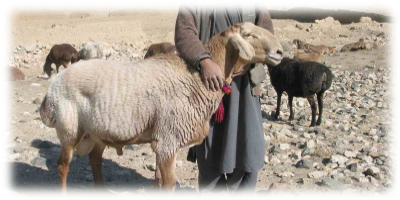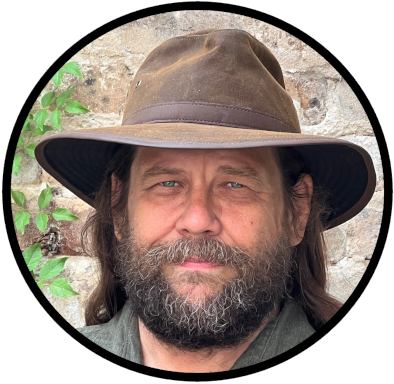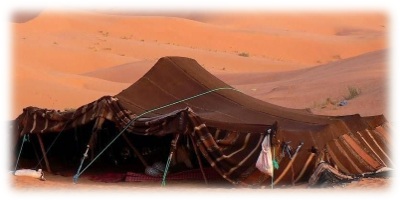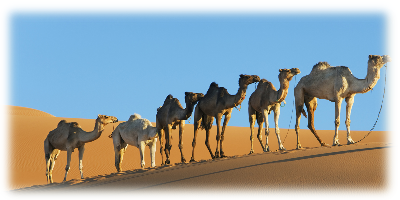Many Biblical characters, such as Abraham, Isaac, Jacob, Moses, David and others, lived a nomadic lifestyle. A nomad lived in tents and traveled from location to location in search of water and pastures for their livestock.
The Wilderness
The home of the nomad was the wilderness, often dry and arid, but with an occasional oasis, river, water basin and pasture. The nomad was at much at home in the wilderness as we are in our own environment. He also knew the area which he traveled very well. He knew where all the water sources were, where pastures were located at different times of the year and all the landmarks which directed him on his travels.
Rain is the most important element to the nomad as without it, he, his family, his flocks and herds cannot survive. Each area received rain at different times of the year and in different locations. It was the tribe's chief responsibility to ensure that they were at the right places at the right times. The rains may be local, providing water and pasture, but may also be very distant. These distant rains would flood the rivers causing them to overflow and watering the grounds near the rivers within their areas of travel.
Possessions
The nomad lived a very simple life and because of their constant travels they could not carry a great number of supplies and equipment. His major possession is the tent made of goat hair, the poles, stakes and ropes for supporting the tent, a curtain to divide the tent into two parts (male and female sides) and a carpet for the floor. The nomad's wealth was measured by the size of his flocks and herds which supplied him with most of his needs including milk, meat, skin, hair for tents, horns for trumpets and liquid containers and many other odds and ends.
His cooking supplies and equipment consisted of bags made of skins for carrying food reserves such as grains and dried fruits, a few utensils such as spoons, knives and bowls and a grinding mill for making flour out of grains. He also carried some harvesting supplies such as sickles and mattocks to gather crops when available. For defense he also carried weapons such as the bow and arrow, spears and knives. Many of his weapons were used for other purposes such as butchering knives, mattocks and the tent poles which were sharp at one end for spears.
Family
A nomadic camp consisted of about 25 to 50 members. Any less and it would be difficult to protect the family and any more would be difficult to feed. Usually, the oldest member of the family was the head, or chief, of the tribe. The remainder of the clan would consist of his brothers, sons, nephews and grandsons as well as their wives and children. Each clan was an independent entity with the chief as judge and ruler. He had the ultimate authority in all manners including where they go, discipline, management of the flocks and herds and the daily tasks of the camp.
When a clan became too large to support, it was divided and separated with all of the clans belonging to one tribe. The name of the tribe was generally that of the original family patriarch and each clan of the tribe carried the name of its original patriarch.
Foods and Medicines
The nomad's diet consisted of breads, fruits (when available), milk and cheese and meat. Grains, such as barley and wheat, were gathered and ground into a flour and mixed with water and placed on hot rocks to make bread. Some of the fruits available were grapes, pomegranates, olives and dates. These were often dried for later use and sometimes mixed with flour for a cake type bread. Milk was taken from the sheep and goats and also used to make cheese. Animals from the flock were occasionally butchered especially for special events such as when guests arrive but, not on a regular basis.
Olives were not only used as a food source but for medicinal purposes as well. It was drunk for stomach and intestinal problems and applied to wounds as an antiseptic. The fat of animals was made into a soap for washing.
Social Activities
The men would often gather together, usually at meal times, to discuss past events, needs, locations and other details of operating the camp. The women gathered together to prepare foods, make clothing and make tent repairs. Storytelling was probably one of the most important forms of entertainment. The older members of the clan would tell the stories of their history to the children in order to pass on the experiences of the tribe and clans to the next generation.
One of the major responsibilities of the clan is to provide hospitality to anyone who comes to them. This may be a member of a related clan or even an enemy of another tribe. In both cases it was the responsibility of the clan to provide food, shelter and protection as long as they were within their camp.
Religion
The religion of the nomads is very different from our understanding of religion. The whole of the nomads life was his religion. As his very existence was dependent upon rain, he understood that his life was in God's hands at all times. The nomad saw the power, justice, love and mercy of God in all things and in all of his activities, such as eating, making shelter, working, etc. was seen as a service to God. The nomad lived in harmony with his surroundings and understood as being one with God who created all things. In short, his life was one long prayer to God.

Like what you’re discovering? Continue the journey from Bible reader to translator.
|






